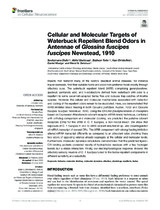Cellular and molecular targets of waterbuck repellent blend odors in antennae of glossina fuscipes fuscipes newstead, 1910

View/
Date
2020Author
Diallo, Souleymane
Shahbaaz, Mohd
Torto, Baldwyn
Metadata
Show full item recordAbstract
Insects that transmit many of the world’s deadliest animal diseases, for instance
trypanosomosis, find their suitable hosts and avoid non-preferred hosts mostly through
olfactory cues. The waterbuck repellent blend (WRB) comprising geranylacetone,
guaiacol, pentanoic acid, and d-octalactone derived from waterbuck skin odor is a
repellent to some savannah-adapted tsetse flies and reduces trap catches of riverine
species. However, the cellular and molecular mechanisms associated with detection
and coding of the repellent odors remain to be elucidated. Here, we demonstrated that
WRB inhibited blood feeding in both Glossina pallidipes Austen, 1903 and Glossina
fuscipes fuscipes Newstead, 1910. Using the DREAM (Deorphanization of Receptors
based on Expression Alterations in odorant receptor mRNA levels) technique, combined
with ortholog comparison and molecular docking, we predicted the putative odorant
receptors (ORs) for the WRB in G. f. fuscipes, a non-model insect.
